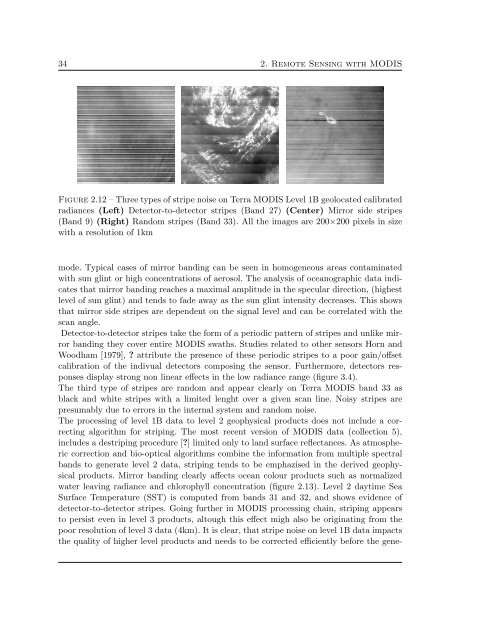Th`ese Marouan BOUALI - Sites personnels de TELECOM ParisTech
Th`ese Marouan BOUALI - Sites personnels de TELECOM ParisTech
Th`ese Marouan BOUALI - Sites personnels de TELECOM ParisTech
You also want an ePaper? Increase the reach of your titles
YUMPU automatically turns print PDFs into web optimized ePapers that Google loves.
34 2. Remote Sensing with MODIS<br />
Figure 2.12 – Three types of stripe noise on Terra MODIS Level 1B geolocated calibrated<br />
radiances (Left) Detector-to-<strong>de</strong>tector stripes (Band 27) (Center) Mirror si<strong>de</strong> stripes<br />
(Band 9) (Right) Random stripes (Band 33). All the images are 200×200 pixels in size<br />
with a resolution of 1km<br />
mo<strong>de</strong>. Typical cases of mirror banding can be seen in homogeneous areas contaminated<br />
with sun glint or high concentrations of aerosol. The analysis of oceanographic data indicates<br />
that mirror banding reaches a maximal amplitu<strong>de</strong> in the specular direction, (highest<br />
level of sun glint) and tends to fa<strong>de</strong> away as the sun glint intensity <strong>de</strong>creases. This shows<br />
that mirror si<strong>de</strong> stripes are <strong>de</strong>pen<strong>de</strong>nt on the signal level and can be correlated with the<br />
scan angle.<br />
Detector-to-<strong>de</strong>tector stripes take the form of a periodic pattern of stripes and unlike mirror<br />
banding they cover entire MODIS swaths. Studies related to other sensors Horn and<br />
Woodham [1979], attribute the presence of these periodic stripes to a poor gain/offset<br />
calibration of the indivual <strong>de</strong>tectors composing the sensor. Furthermore, <strong>de</strong>tectors responses<br />
display strong non linear effects in the low radiance range (figure 3.4).<br />
The third type of stripes are random and appear clearly on Terra MODIS band 33 as<br />
black and white stripes with a limited lenght over a given scan line. Noisy stripes are<br />
presumably due to errors in the internal system and random noise.<br />
The processing of level 1B data to level 2 geophysical products does not inclu<strong>de</strong> a correcting<br />
algorithm for striping. The most recent version of MODIS data (collection 5),<br />
inclu<strong>de</strong>s a <strong>de</strong>striping procedure [] limited only to land surface reflectances. As atmospheric<br />
correction and bio-optical algorithms combine the information from multiple spectral<br />
bands to generate level 2 data, striping tends to be emphazised in the <strong>de</strong>rived geophysical<br />
products. Mirror banding clearly affects ocean colour products such as normalized<br />
water leaving radiance and chlorophyll concentration (figure 2.13). Level 2 daytime Sea<br />
Surface Temperature (SST) is computed from bands 31 and 32, and shows evi<strong>de</strong>nce of<br />
<strong>de</strong>tector-to-<strong>de</strong>tector stripes. Going further in MODIS processing chain, striping appears<br />
to persist even in level 3 products, altough this effect migh also be originating from the<br />
poor resolution of level 3 data (4km). It is clear, that stripe noise on level 1B data impacts<br />
the quality of higher level products and needs to be corrected efficiently before the gene-















